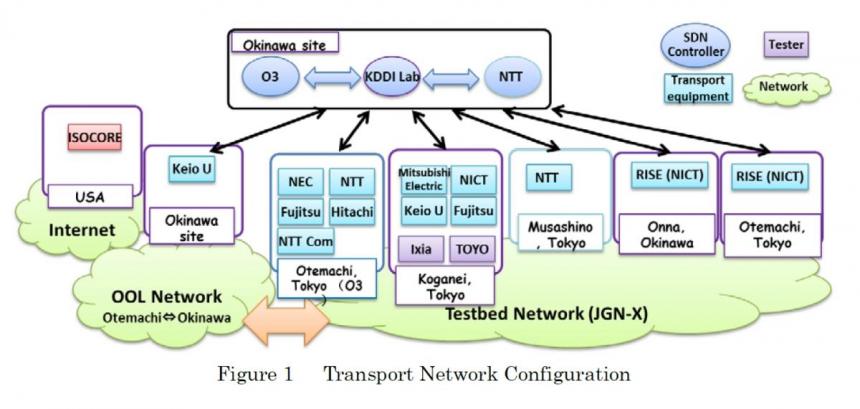 Print
Print
Successful nationwide flow/path setting by multiple SDN controllers through different optical transport networks mutually connected --Toward the realization of a future, world-scale,integrated network service--
April 20, 2015
KDDI R&D Laboratories, Inc.
Mitsubishi Electric Corporation
National Institute of Information and Communications Technology
Keio University
Fujitsu Limited
Ixia Communications K.K.
TOYO Corporation
KDDI R&D Laboratories, Inc. (“KDDI R&D Labs.,” President & CEO: Yasuyuki Nakajima), Mitsubishi Electric Corporation (“Mitsubishi Electric,” President & CEO: Masaki Sakuyama), National Institute of Information and Communications Technology (“NICT,” President: Dr. Masao Sakauchi), Keio University (“Keio Univ.,” President, Professor: Atsushi Seike), Fujitsu Limited (“Fujitsu,” President & CEO: Masami Yamamoto), Ixia Communications K.K. (“Ixia,” County General Manager: Kenji Murakami), and TOYO Corporation (“TOYO,” President and CEO: Masaru Gomi) succeeded in an interoperability experiment of constructing a nationwide optical transport network.[*1] It comprised several network domains with different communication technologies, control methods, and architectures, and dynamically produced a seamless traffic flow across the domains using SDN (Software Defined Networking) technology.[*2] This technology is expected to be applied to the construction of a future, world-scale, integrated network service, which combines network services and various cloud services.
This open interoperability demonstration is being conducted at the 11th International Conference on IP + Optical Network (iPOP2015) to be held in Naha between April 20 and 22.
[Background]
With the commoditization of global human and product distribution arose a growing demand for communication services that can be seamlessly provided from anywhere in the world. Networks are configured on a national or regional basis by communication carriers using different architectures and technologies depending on the regional conditions. While the centralized control of several of these enables communication services to be promptly established and provided across networks, it was considered difficult to realize due to numerous reasons, such as immense processing and the dependency on all technologies.
[Project results and open demonstration outline]
The team succeeded in an interoperability experiment of configuring a traffic flow across several transport network domains by constructing a large-scale transport network (see Figure 1). This network connected nationwide transport networks constructed with different technologies using a new generation communication network test bed, such as JGN-X,[*3] thus enabling the linked control of the SDN controllers deployed in the network domains.
The open demonstration at the iPOP2015 international conference held from April 20 through 22 is showing how several traffic flows can be configured, connecting bases in Tokyo area to the iPOP2015 venue (Okinawa), remotely controlled by a SDN/OpenFlow[*8]-based control system. The seven transport networks consist of domains constructed at three bases in Tokyo (Koganei, Musashino, Otemachi) and at one base in Okinawa (iPOP2015 venue); the RISE test bed[*6] network domains (RISE Okinawa, RISE Tokyo), which have been deployed in across Japan; and a base in the United States (ISOCORE[*7]) via the Internet—in cooperation with Nippon Telegraph and Telephone Corporation (NTT), Okinawa Open Laboratory (OOL)[*4], and the “O3 Project,”[*5] a research and development project aimed at applying SDNs to a wide area network.
The transport domain built in the NICT Koganei is an optical aggregation network constructed as a multi-domain/multi-technology transport network controlled by an SDN/OpenFlow-based control system, using a large-capacity metro core optical network comprising a 100Gbit/s-class DWDM transport system[*9] (supplied by Mitsubishi Electric) and a 100Gbit/s-class optical packet and optical circuit integrated network system[*10] (supplied by NICT); and an elastic[*11] device prototype[*13] of a next-generation optical aggregation network[*12] (supplied by Keio Univ.) with a virtual node[*14] (supplied by Fujitsu), which performs high-speed packet transmission over a wide-area network. The optical aggregation network will be remotely controlled by an integrated control system[*15] (supplied by KDDI R&D Labs.) installed at the iPOP2015 venue to configure a virtual optical network.
The transport network domain built in NTT Musashino manages switches as virtual resources[*16] and swiftly constructs a virtual network according to instructions from the SDN/OpenFlow-based control system. At the same time, the domain controller implements traffic engineering, such as the dynamic path optimization of the transport path according to the network’s condition.
At the RISE Okinawa base, virtual machines simulate a data center and create a transport network domain using the RISE test bed for interoperability among the data centers with the virtual machines at the Tokyo bases. A next-generation optical aggregation prototype (supplied by Keio University) and the SDN/OpenFlow-based control systems that control the respective transport network domains are deployed at the iPOP2015 venue to configure a wide-area transport network domain built in NTT Musashino in connected to the transport domains at the bases in Tokyo.
A network tester is deployed at the United States base to provide background traffic to the NICT Koganei via the Internet. The background traffic is generated in the ISOCORE interoperability lab. and flows to the iPOP2015 venue.
This is the first open demonstration[*17] of an SDN/OpenFlow control of a nationwide network that mutually connects transport networks constructed at seven locations in Japan and the United States.

[*1] Optical Transport Network:
The Optical Transport Network is a communications network base and a network that transfers data using optical signals.
[*2] SDN (Software Defined Networking) technology:
SDN (Software Defined Networking) technology is a network technology that enables network configuration to be dynamically set and changed using software.
[*3] New-Generation Network Test Bed JGN-X:
The New-Generation Network Test Bed JGN-X is a new test bed environment for realizing and expanding new-generation network technologies that have been operated by NICT since April 2011. It is widely available for research and development.
[*4] Okinawa Open Laboratory:
Okinawa Open Laboratory (OOL) promotes international collaborative activities with open communities and standardization promoting groups. It also openly and internationally promotes research and development activities to encourage the nurturing of engineers involved in the technical field with the participation of leading companies, groups, and educational and research institutions in Japan and across Asia. The OOL’s objective is to implement and disseminate next-generation ICT fundamental technologies integrated with cloud computing and Software-Defined Networking (SDN). OOL is also an iPOP2015 organizer.
[*5] O3 Project:
In the O3 Project, Nippon Electric Co. Ltd., NTT Communications Corporation, NTT, Fujitsu, and Hitachi Ltd. are involved in the research and development of wide-area virtual network integration and control as a research project consigned by the Ministry of Internal Affairs and Communications’ “Research and Development of Network Virtualization Technology.” The results are partly disclosed as OSS (Open Source Software). http://www.o3project.org
[*6] RISE Test Bed:
RISE Test Bed is a wide-area test bed environment for SDN/OpenFlow technologies, a service begun on JGN-X by NICT in October 2011. It is widely available, as is JGN-X. With OpenFlow switches deployed at 11 domestic bases and five overseas bases, and an ICT environment in a virtual host environment, users can conduct a demonstration experiment of large-scale infrastructure control using their own controller software.
[*7] ISOCORE:
ISOCORE (http://www.isocore.com/) is a corporation based in Virginia, USA, that provides a mutual connectivity verification service. ISOCORE verification greatly influences MPLS and SDN standardization. ISOCORE is also an iPOP2015 organizer.
[*8] OpenFlow:
OpenFlow is the registered trademark of Open Networking Foundation (ONF).
[*9] 100Gbit/s-class DWDM transport system:
100Gbit/s-class DWDM transport system is an optical communication device that transmits multiplexed wavelengths on a single optical fiber. The device used in this interoperability experiment enables transmission of 100 Gbit/s signals per wavelength and several Tera bits/s signals per optical fiber. Part of this research and development uses the results of studies, which were conducted between FY2009 and FY2011, commissioned by the Ministry of Internal Affairs and Communications’ “Ultra-high-speed Optical Transmission System Technology (Digital Coherent Optical Transmission and Receiving Technology)” and “Research and Development of Ultra-high-speed Optical Edge Node Technology.”
[*10] 100 Gbit/s-class optical packet and circuit integration network system:
The 100 Gbit/s-class optical packet and circuit integration network system is an optical system that provides a communication channel for various purposes. For example, it provides an optical circuit for end users who require high quality, such as high-definition video transmission, remote medical treatment, and TV conferences. It also provides optical packet switching used in the transmission of emails and Web access data, and the transmission of sensor data from super large terminals. This system uses results from the NICT R&Ds: “Research and Development of the New-generation Network Fundamental Technologies” and “Research and Development of Photonic Network Technologies.”
[*11] Elastic:
Elastic refers to the nature that allows users to flexibly change the signal bandwidth according to the requested bandwidth.
[*12] Next-generation Optical Aggregation Network:
The Next-generation Optical Aggregation Network resides between the access networks for locally deployed services and the core networks connecting communication stations. It serves as a concentrator network for all services that aggregate traffic from access networks before forwarding it to the core networks. The next-generation optical aggregation network is aimed at realizing an integrated network supporting each service using the network virtualization technology and SDN technology by extending the Fiber to the Home (FTTH) technology and expanding the part where signals are converted into optical signals by integrating the aggregation network into the access network to create the active optical distribution network.
[*13] Prototype:
The prototype supplied by Keio University was created based on the results of the NICT-commissioned “Research and development on elastic optical aggregation technology” research project.
[*14] Virtual node:
The Fujitsu’s “Fujitsu Network Virtuora SN-V” is a software switch that supports resource virtualization for a wide-area network. It runs on an IA server and realizes high-speed data communication with Fujitsu’s proprietary packet processing technology and autonomous path switching. It is also compliant with OpenFlow1.3 standard interfaces.
(Reference) Fujitsu Network Virtuora SN-V:
http://www.fujitsu.com/global/about/resources/news/press-releases/2014/0509-01.html
[*15] Integrated Control System:
The integrated control system (prototype) supplied by KDDI R&D Labs. was created based on the results of the MIC-commissioned “Scalable and efficient orchestration of Ethernet services using software-defined and flexible optical networks (STRAUSS)” project.
[*16] Switches as Virtual Resources:
Switches as Virtual Resources is a network configuration method for the maximum use of multi-purpose products with simple functions without relying on dedicated devices, such as highly functional edge routers and core routers that vary depending on the applications.
(Reference) Multi Service Fabric:
http://www.ntt.co.jp/news2015/1502/150219a.html
[*17] First open demonstration of the SDN/OpenFlow control of the nation-wide network:
The first open demonstration of the SDN/OpenFlow control of a nation-wide network will be conducted as part of the “Research and development project on Multi-Technology Transport Network Control Technology” promoted by the Interoperability Working Group (Chair: Naoaki Yamanaka, Professor for Faculty of Science and Technology, Keio Univ.) of the Research Promotion Council of Keihanna Info-Communication Open Lab. This council has been working to contribute to the development of economy in the Kansai region by promoting the research and development in the ICT field through government-industry-academia collaboration. The Interoperability Working Group consisting of 9 organizations including KDDI R&D Labs., Mitsubishi Electric, NICT, Keio Univ. and Fujitsu is one of the working groups of this council and has been making various proposals and performing verification on the interoperability of the next-generation optical network.
※The information contained in the articles is current at the time of publication.Products, service fees, service content and specifications, contact information, and other details are subject to change without notice.